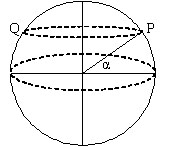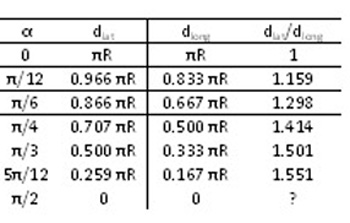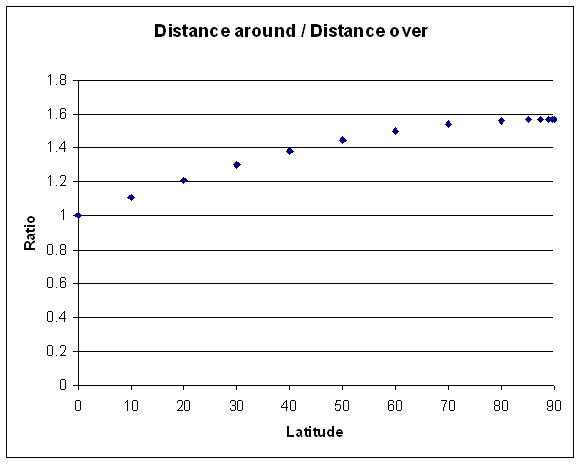Skip over navigation



Or search by topic
Number and algebra
Geometry and measure
Probability and statistics
Working mathematically
Advanced mathematics
For younger learners
Over the Pole
Age 16 to 18
Challenge Level 





- Problem
- Getting Started
- Student Solutions
- Teachers' Resources
Simon from Elizabeth College, Guernsey and Andrei from Tudor Vianu National College, Romania have both solved this problem and both solutions are used below.
 |
To solve this problem we shall consider that the point is
situated at latitude $\alpha$. To travel around the line of
latitude, the distance from P to Q would be half the circumference
of the circle at latitude $\alpha$. This circle has a radius $R
\cos \alpha$, where $R$ is the radius of Earth.
So, the distance traveled from P to Q on the line of latitude
is $d_{lat} = \pi R \cos \alpha$.
|
|
Traveling over the line of longitude, the circle on which we
have to calculate the distance is a great circle of the sphere, and
the angle of displacement is $2(\pi /2 - \alpha)$ radians. The
distance is therefore $4\pi R(90-L)/360$ where $L$ is the angle of
latitude in degrees or equivalently $d_{long} = 2R (\pi/2 -
\alpha)$.
It is clear that the path on a great circle is always
shorter.
|
 |
 |
A graph of the ratio of these distances shows that this ratio
seems to tend to $\pi /2$ as the line of latitude approaches the
pole, that is the ratio $${d_{lat}\over d_{long}}= {\pi R \cos
\alpha \over 2R (\pi/2 - \alpha)}$$ tends to a limit as $\alpha \to
\pi/2$.
This ratio can also be written as $${d_{lat}\over d_{long}}=
{\pi R \sin (\pi/2- \alpha) \over 2R (\pi/2 - \alpha)}.$$ As we
know ${\theta\over \sin \theta} \to 1 $ as $\theta \to 0$ we can
take $\theta = \pi/2 - \alpha $ and we see that this limit is $\pi
/2$.
|
Andrei calculated this limit using L'Hopital's Rule (case
$0/0$): $$\lim_{\alpha\to \pi/2}{\pi R\cos \alpha \over R(\pi
-2\alpha)} = \lim_{\alpha\to \pi/2}{\pi \cos \alpha \over (\pi
-2\alpha)} = \lim_{\alpha\to \pi/2}{-\pi \sin \alpha \over -2} =
{\pi \over 2} \approx 1.57$$
You may also like
How Many Geometries Are There?
An account of how axioms underpin geometry and how by changing one axiom we get an entirely different geometry.
When the Angles of a Triangle Don't Add up to 180 Degrees
This article outlines the underlying axioms of spherical geometry giving a simple proof that the sum of the angles of a triangle on the surface of a unit sphere is equal to pi plus the area of the triangle.
Flight Path
Use simple trigonometry to calculate the distance along the flight path from London to Sydney.

